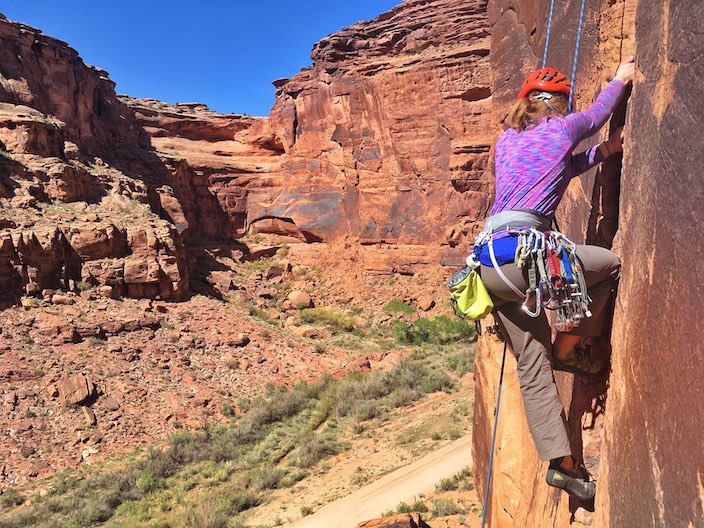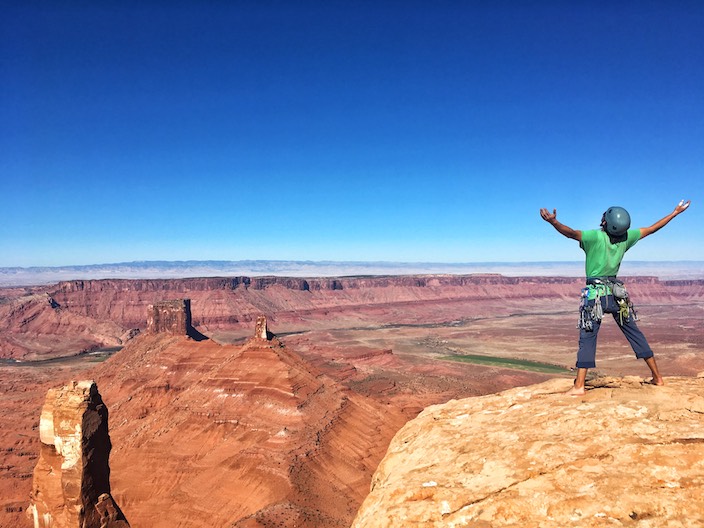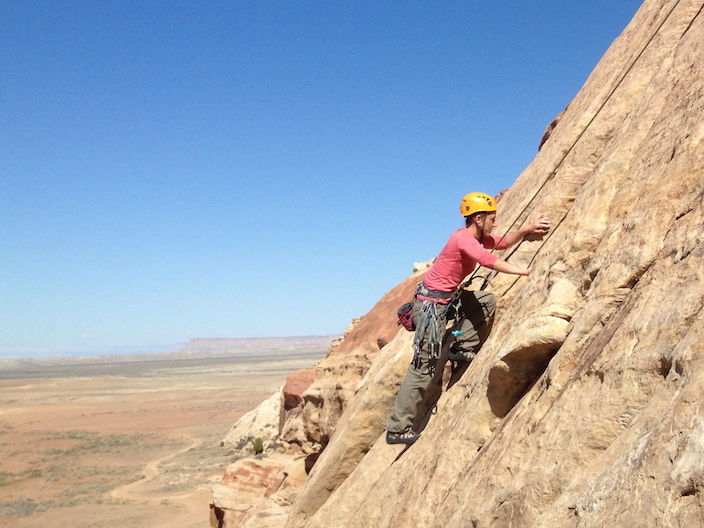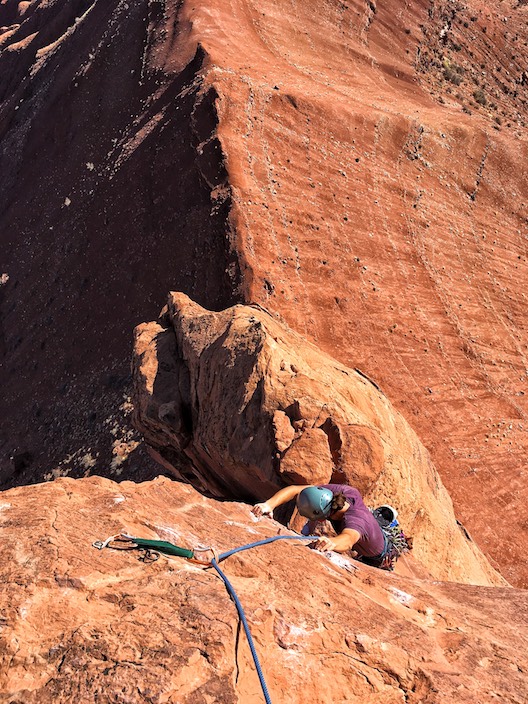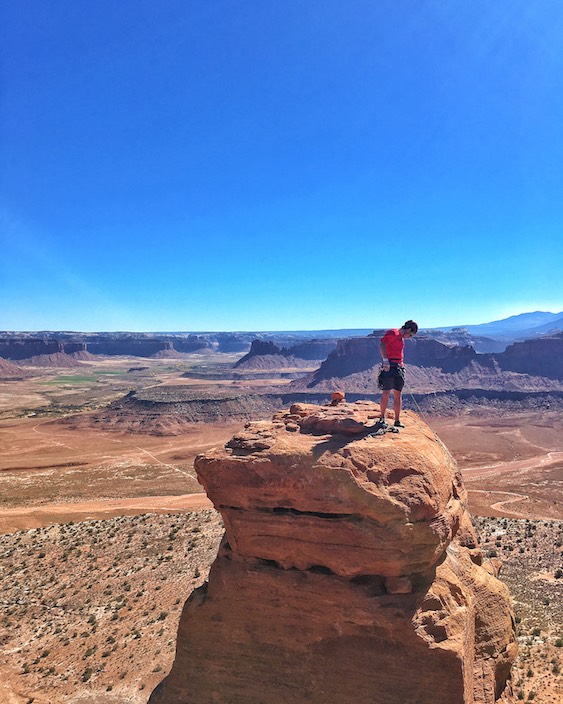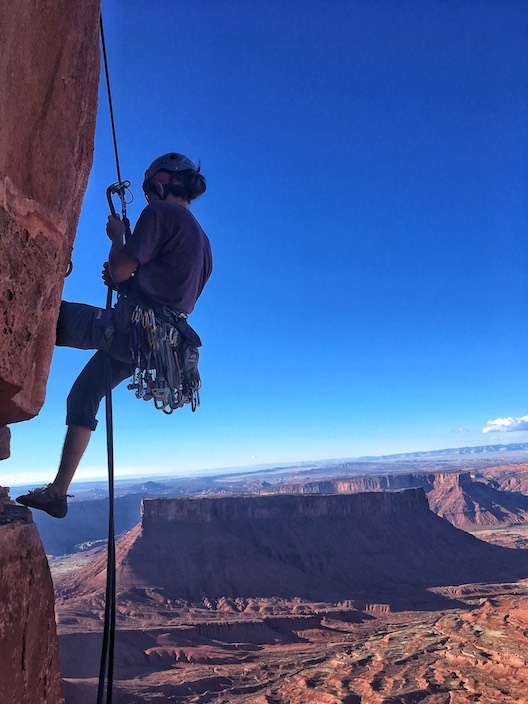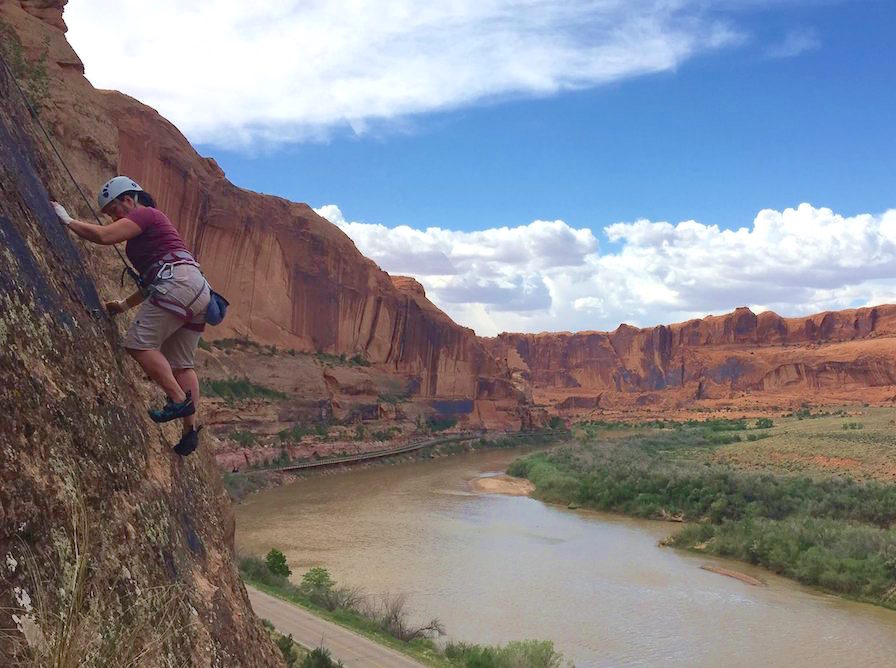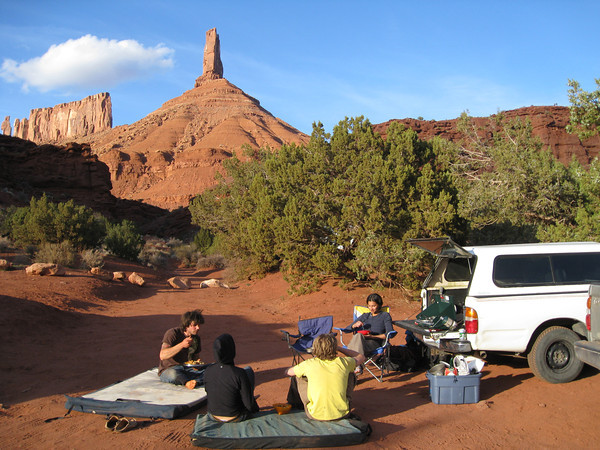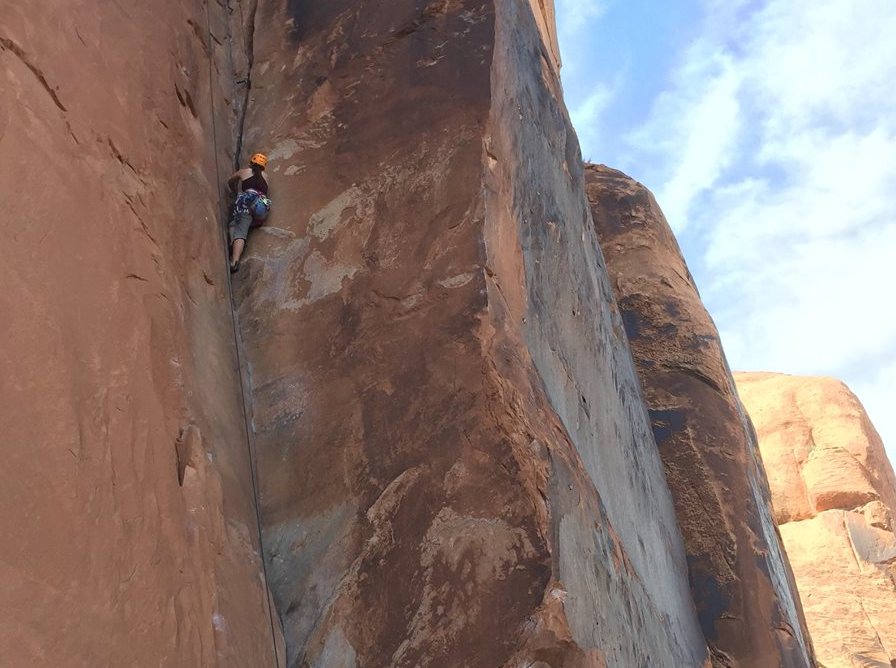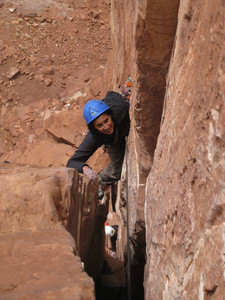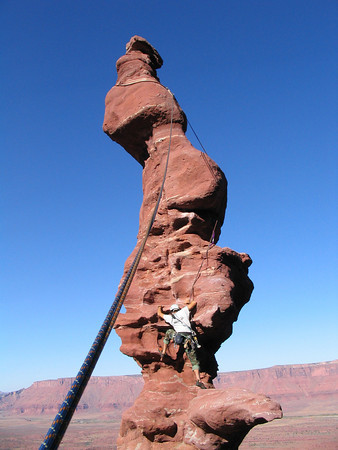Guided Rock Climbing in Moab & Indian Creek Overview Introduction to the Area
A climber enjoys some moderate terrain on wingate sandstone. Andy Bourne
Nestled between Arches National Park, Canyonlands National Park, and Deadhorse Point State Park, high on the Colorado Plateau, the tiny hamlet of Moab is considered by many to be the adventure capitol of Utah. This little resort town is surrounded by some of the most amazing red rock scenery in the world. People come from all over the planet to sample the area's river rafting, mountain biking, canyoneering and, of course, rock climbing.
Rock climbing in the Moab area is a completely unique experience. Much more than other areas, the terrain is broken into deep canyons, detached pinnacles, and towers that rise above the desert. Castleton Tower, Ancient Art, and the Titan in the Fisher Towers are just a few examples.
The various sandstone formations that make up the region's crags produce a wide range of climbing challenges. Hard Wingate sandstone breaks into clean-sided cracks that demand strong jamming technique. Cutler sandstone is much softer; areas like the Fisher Towers, with its crazy erosion patterns, show this sandstone's distinct qualities, with gritty, rounded holds and mind-bending offwidths.
Those who come from a face-climbing or a gym climbing background will be introduced to a whole new world of climbing. Those who are already familiar with crack climbing techniques will be able to significantly advance their skills. The need to use such a wide array of crack climbing techniques in such a focused setting will ultimately lend itself to mastery.
Moab Area Climbing at a Glance Courses and guided climbing offered every day in the fall and spring seasons: September through November, and March through May.
Choose climbs in Castle Valley, the Fisher Towers, or Indian Creek
Participate in a public group course, or arrange a private climb with a guide and one or two friends.
Climb short routes to work on technique, or climb classic, long desert tower routes.
Camp outside or stay in a hotel/motel in Moab.
Courses and private instruction available at beginner, intermediate and advanced levels.
Guided Rock Climbing in Moab & Indian Creek Locations and Routes Cragging and Instruction Outside of Moab The town of Moab is surrounded by rock. Climbs of all ability levels are available, just minutes from downtown Moab. Indeed, one of the great advantages to climbing in Moab is the ease of access. Many of the practice crags just outside of town are so close to the road that you can literally open your car door and put on your harness. These quick approaches allow you to maximize your time developing your technical and movement skills.
Beginner level climbers will generally work at one of these roadside crags, developing a wide-array of base-level climbing skills, including belay techniques, knot practice, equipment selection, anchoring and climbing commands. Additionally, beginners will work on climbing movement skills which will include hand, foot and finger jamming techniques, hand and foot placement for economy of movement, body positioning and balance, as well as proper positioning to save energy and strength.
Intermediate and advanced level climbers may continue to work on climbing movement skills to refine their crack climbing techniques. However, they may also focus on multi-pitch technique, lead technique, direct aid technique, or rock rescue.
Desert Tower Climbs There are few things in this world that can give a climber goose-bumps like the idea of standing on top of a tiny summit, hundreds of feet off the ground. Moab and the surrounding areas offer some of the best desert tower climbing in the world. Southeast Utah is chock full of towers with routes available for all ability levels, though the bulk of the routes do tend to be for intermediate and advanced level climbers.
Here is a sample of some of the most popular Moab area towers:
A climber on the iconic corkscrew climb, 'Ancient Art.' Josh Wonner
Castleton Tower: A unique tower that stands alone four-hundred feet above the desert floor is perhaps the most famous of the desert towers. The Kor-Ingalls Route (III, 5.9) on the south face has the distinction of being one of the prestigious Fifty Classic Climbs in North America. This classic line offers up a bit of everything, from off-width climbing to hand cracks to a squeeze chimney. It is a route not to be missed! When the desert sun is too warm, an excellent alternative to the Kor-Ingalls is the equally enjoyable North Chimney (III, 5.9). By any means, Castleton Tower is one of the most enjoyable climbs in the area.
The Priest: Found just north of Castleton Tower, this feature looks like a Priest blessing the approaching climber. The most popular line on this 330-foot tall tower is the Honeymoon Chimney (III, 5.9, A0), which as you might have suspected, includes a lot of engaging chimney climbing. Ancient Art, Stolen Chimney: One of the most amazing summits in the entire region, the bulbous top of Ancient Art looks like something Salvador Dali might paint if he were asked to render a desert tower. Five pitches of varied climbing, including a crawl across a foot-wide ridge top, and a wild mantle over a diving board-shaped feature lead to this absolutely stunning summit (III, 5.8, A0).
The Lighthouse Tower: Another peak with a tiny summit that will only hold one person at a time, this 315-foot tall tower has two intermediate-level routes, the Posiden Adventure (III, 5.9+) and Lonely Vigil (II, 5.10).
The American Alpine Institute has access to dozens of towers throughout the region. Many of the towers require aid climbing to successfully climb. These provide a perfect venue to develop your aid and big wall climbing skills.
Indian Creek Canyon Pioneered in the mid-1970's, Indian Creek is often referred to as the crack climbing capitol of the world. This deep rift just east of Canyonlands National Park is home to thousands upon thousands of beautiful parallel-sided cracks. These laser-straight splitters climb up stunning cliff faces of rust-red Wingate sandstone above a scenic, arid valley of sagebrush and scrub. This combination of great rock, beautiful scenery and perfect crack climbing has made the area a world-class rock climbing destination and a must visit area for intermediate and advanced level climbers.
An AAI student practicing his newly learned fist jamming technique on a classic Indian Creek climb. Zach Lovell.
Classics of the area include:
Twin Cracks (I, 5.8+ or 5.9): A classic corner jamming climb that is made more interesting by the option to do stemming or chimney-like moves.Supercrack (of the Desert), (I, 5.10+ or 5.11 - full climb): The climb that changed everything, this climb ushered in the modern era of ultra-pure Indian Creek jamming. Called "Supercrack of the Desert" to distinguish it from the substantially harder Supercrack in New York's Shawangunks.Gorilla Crack (I, 5.10a or b): A lovely long crack that joins a corner near the top, the width varies from tight hands to offwidth.Bridger Jacks, Sunflower Tower (I, 5.10+): The Bridger Jacks are a rib of picturesque, freestanding pinnacles. Sunflower Tower's East face is a three-pitch classic for accomplished crack climbers.
Getting to Moab Though most people elect to drive to Moab from Grand Junction, Colorado, or Salt Lake City, Utah, Great Lakes Airlines connects directly to the Moab Airport from both Page, AZ as well as from Las Vegas, NV.
Guided Rock Climbing in Moab & Indian Creek Pricing, Details and Dates The following programs are offered in a variety of locations, though they are not offered in every location every year. All programs may be completed on a private basis.
Half-Day Private Courses (pricing is per person, per day)
1:1 = $385; 2:1 = $245; 3:1 = $190; 4:1 = $175; 5:1 = $155; 6:1 = $135
Available for Beginner, Intermediate and Advanced Level courses. Half-day courses may be run in the morning or the afternoon.
Full Day Private Courses (pricing is per person, per day)
1:1 = $430; 2:1 = $305; 3:1 = $245; 4:1 = $215; 5:1 = $185; 6:1 = $160
Available for Beginner, Intermediate and Advanced Level courses. For cragging courses, the meeting time will be at 8:00am with a return by 5:00pm. Meeting times for significant ascents may be earlier depending on the commitment level required of the route.
Guided Rock Climbing in Moab & Indian Creek Related Courses
Program Finder
By Location
United States - Alaska
United States - Washington
United States - California
United States - Nevada
United States - Colorado
United States - Utah
Canada - British Columbia
South America - Argentina
South America - Bolivia
South America - Ecuador
South America - Patagonia
South America - Peru
Europe - Alps and Caucasus
Asia - Nepal and Tibet
Asia - Laos, Thailand, & Vietnam
Asia - China
Asia - Japan
Africa - Tanzania
Pacific and Antarctica
By Program Type
Instructional Courses
Group Summit Climbs
Expeditions
Skills Expeditions
Private Guided Programs
Treks, Tours, & Backpacking
Corporate Outings & Services
Government & Military
By Activity
Rock Climbing
Ice Climbing
Alpine Climbing
High-Altitude Climbing
Trekking and Backpacking
Skiing & Snowboarding
Guide Training & Rescue
Avalanche Training
Departure Month
Difficulty Level
Beginner
Moderate
Intermediate
Advanced
Very Advanced
x
